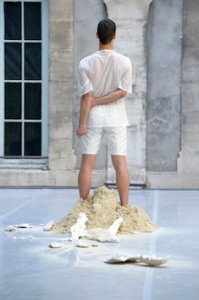
CURTAIN by Jonah Bokaer © Pascal Gely / SACD Performance Jonah Bokaer; Installation Daniel Arsham; Costume by Richard Chai
Jacob’s Pillow
Jonah Bokaer
Doris Duke Theatre
August 1-5, 2012
U.S. Premiere
“Curtain”
Review by Seth Rogovoy
(BECKET, Mass., Wednesday, August 1, 2012) – “Pay no attention to the man behind the curtain.” But what if you don’t know who is behind the curtain and who is in front? Or where the curtain even is? What if there is no curtain at all?
Questions like these abound in Jonah Bokaer’s Curtain, a full-length performance being given its U.S. premiere this week at Jacob’s Pillow. Performance is the word, as opposed to dance, because while dance plays a role – a significant role – and while Bokaer is a dancer (a former Merce Cunningham dancer, in fact) and an award-winning choreographer, what Bokaer puts onstage – what his creative team stages – can’t be summed up in the word dance – even when the dancer himself is in large part the only (human) performer onstage.
In Bokaer’s hands, and in his vision, and in Curtain, dance collides with design, sculpture and architecture – as well as more conventional bedfellows like music and lighting. But it’s an organic, graceful collision – really, not so much a collision as a, well, as a dance. Dance dances with sculpture and the visual arts in the world according to Bokaer, and in the world of Curtain, propelled by Daniel Arsham’s scenography, sculptures and design, Chris Garneau’s original score, and John Torres’s essential lighting design. And, of course, propelled by Bokaer’s singular, original movement vocabulary.
In the beginning, there is none. No curtain, that is – at least none that can be seen. There are surprises over the course of the evening, and even several moments of shock and awe, but there will be no spoilers here. It’s not giving away much to say that the scene begins by taking advantage of the view outside the back door of the Duke studio, with the door open to an Edenic view at twilight, with trees in full foliage and fading light casting a glow on the shingled roof of a cabin. A man stands facing the scene, with his back to the audience, in the glow of a light. It’s a motif that will be repeated throughout the evening. And it already, at the beginning, raises questions of beginnings and endings, where do beginnings start (as the man is already there when we take our seats), and is the view meant to be taken literally (as in, the view behind the Doris Duke Studio at Jacob’s Pillow) or representionally (as in, a view of nature, or a painting or a film).
Onstage there are two sculptural objects on the floor – we’ll give one the name “humanoid,” as he will be with us for most of the evening, and we’ll call the other “the blob,” as, at least at first, it seems to like human reference. The sculptures are lit up, white and blue, and off in the dark of the stage, on the floor, there are two real humans.
The man in the frame of the back wall of the Duke turns around and discovers the ability to move. The man, of course, is Jonah Bokaer – who studied contemporary movement strategies over a decade ago at the School at Jacob’s Pillow, just a few dozen yards from where he stands now – and as Chris Garneau’s functionally minimalist, Brian Eno-influenced electronic plus vocal score seeks tonal resolution, so does the dancer seek to resolve the twists and curves and angles of his hands and limbs and torso. Just as the layered music evolves, with the rhythmic pulse overwhelming the shimmering soundscape, so do Bokaer’s movements uncover and reveal themselves in their own shape-shifting minimalism. It’s stunning how powerful such constrained movement can be – less can clearly be so much more, in dance as well as in music.
“It is open … it is by no means closed,” says John Cage, whose voice can faintly be heard on an audio recording taken from a lecture he gave years ago at the Pillow – he of the minimalist gesture, he of the lifelong partnership, creative and otherwise, with Merce Cunningham, who would enlist Bokaer at age 18 to be the youngest member ever of his ensemble.
More happens, although “happens” is not really the word. Shapes shift; sculptures change; viscous substances get poured; the blob morphs; the humanoid stands up; violence occurs; those other two twin functionaries separate and fight and leave; things crawl out from and back into the backyard; doors open and close; maybe there is a curtain after all; the nature of this dance is remarkably “site-specific” and one wonders how different it must be when staged elsewhere, when the Garden of Eden isn’t out the back door – or is it even the back door? Have we actually seen the rear of the performance the entire time? Are the trees the audience? And where did Jonah Bokaer learn such precision and control?
